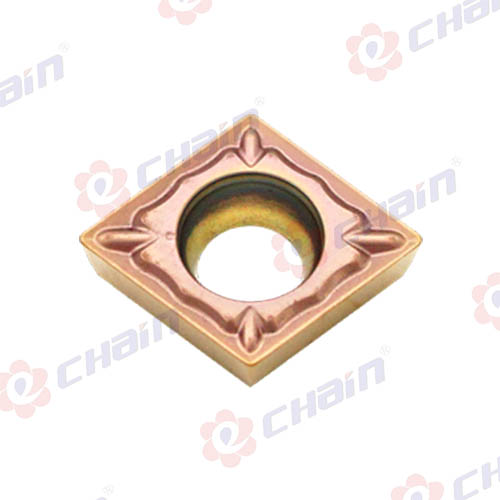What types and specifications are there for carbide cutter heads?
2023-10-18
What types and specifications are there for carbide cutter heads?
Cemented carbide cutter is distinguished by grain size and can be divided into ordinary cemented carbide, fine-grained cemented carbide, sub-fine and ultra-fine-grained cemented carbide, and the newly launched twin-crystal cemented carbide. According to the main chemical composition, it can be divided into tungsten carbide-based cemented carbide and titanium carbide-based cemented carbide. Tungsten carbide-based cemented carbide includes three types: tungsten cobalt (YG), tungsten cobalt titanium (YT) and rare carbide added (YW).
1. YG8 (K30) hardness ≥89.0 is suitable for rough turning, rough planing, rough milling, drilling and enlarging of general holes and deep holes in cast iron, non-ferrous metals and their alloys, and non-metallic materials with uneven surfaces and intermittent cutting. .
2. YG8N (K20K30) hardness ≥90 is suitable for rough machining of cast iron and non-ferrous metals, and is also suitable for rough machining and finishing of stainless steel.
3. YG6X (K10) hardness ≥91.0 is suitable for finishing and semi-finishing of alloy cast iron and ordinary cast iron.
4. YW1 (M10) hardness ≥91.5 is suitable for processing difficult-to-machine steels such as heat-resistant steel, ferrous manganese steel, stainless steel and alloy steel, as well as ordinary steel and cast iron.
5. YW2 (M20) hardness ≥90.5 is suitable for processing difficult-to-machine steels such as heat-resistant steel, high manganese steel, stainless steel and alloy steel, as well as ordinary steel and cast iron.
6. YW3 (M10M20) hardness ≥92 is used for finishing and semi-finishing of stainless steel, alloy steel, high-strength steel, and ultra-high-strength steel. It can also be used for rough machining with low impact force.
7. YS25 (P25) hardness ≥90.5 is suitable for rough turning, milling and planing of carbon steel, cast steel, high manganese steel, high-strength steel and alloy steel.
8. YS30 (P30) hardness ≥90.5 is suitable for high-efficiency milling of various steel materials with large tool passes, especially suitable for milling and gear hobbing of alloy steel.
9. YS8 (M05) hardness ≥92.5 is suitable for finishing of iron-based and nickel-based high-temperature alloys, high-strength steel, chilled cast iron, heat-resistant stainless steel, high manganese steel, and quenched steel.
10. YD05 (K01) hardness ≥93 is specially used for processing various nickel-based, cobalt-based, iron-based and tungsten carbide-containing self-dissolving spray alloy materials.
11. YD15 (K10K20) hardness ≥91.0 is suitable for finishing turning, finishing turning of titanium alloys, nickel-based high-temperature alloys, and also suitable for processing various castings.
12. YD101 is suitable for finishing and semi-finishing of cast iron, non-ferrous metals, especially aluminum. It can also process hard materials such as manganese steel and quenched steel.
13. YT726 hardness ≥93, high red hardness and good wear resistance. Suitable for turning and milling of chilled cast iron and quenched steel.
14. YT798 hardness ≥92.2 has good toughness and high resistance to thermal shock cracking and plastic deformation. Suitable for milling alloy structural steel, alloy tool steel, and also suitable for processing high manganese steel and stainless steel.
carbide cutter Extended information
1. Safety protection: After the blade is installed, before starting the leg cutting machine, the safety shield and other protective devices on the leg cutting machine must be installed in place and play a real protective role (the blade studio on the leg cutting machine should be surrounded by safety baffles , steel plate, rubber and other protective layers).
2. Operating speed: The working speed of the leg cutting machine should be limited to less than 4500 rpm. It is strictly prohibited to operate the leg cutting machine beyond the speed limit!
3. Test machine: After the blade is installed, run the machine empty for 5 minutes, and carefully observe the operating conditions of the foot cutting machine. Obvious looseness, vibration and other abnormal sounds are absolutely not allowed (such as obvious looseness of the foot cutting machine bearings). (axial and end face runout) phenomenon exists. If any abnormality occurs, stop the machine immediately and ask professional maintenance personnel to check the cause of the fault. Only after confirming that the fault is completely eliminated can it be used.
4. During the cutting process, please push the circuit board to be cut at a constant speed. Do not push the circuit board too quickly. When the circuit board collides violently with the blade, it will cause damage to the blade (crash, crack), or even serious safety accidents.
5. Blade storage method: It is strictly forbidden to use an electric engraving pen or other scratching methods to write or mark on the blade to prevent damage to the blade body. The blade of the foot cutting machine is extremely sharp but brittle. To prevent the blade from injuring people or causing accidental damage to the blade, do not touch the blade to the human body or other hard metal objects. The blades to be used should be handed over to dedicated personnel for safekeeping and storage. They must not be left alone to prevent damage to the blades or accidents.
6. The prerequisite for production efficiency is safe operation. Cutting operators must follow relevant usage requirements so that the blade of the foot cutting machine can operate safely on the foot cutting machine.



